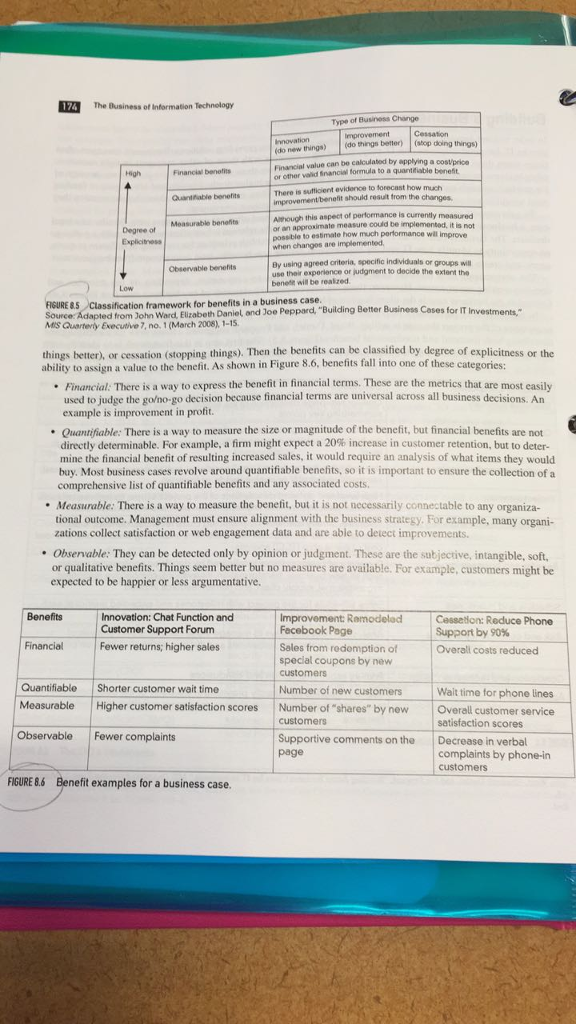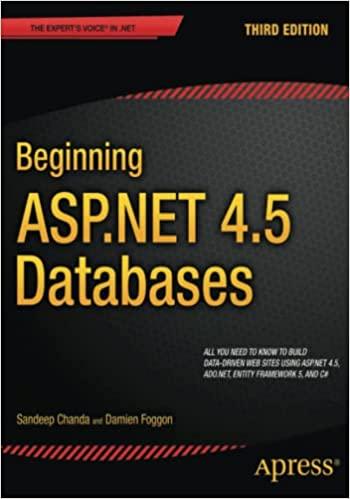Answered step by step
Verified Expert Solution
Question
1 Approved Answer
4. Based on the charts in the text (Figure 8.5 & 8.6), explain the types of business change and benefits expected from a business case

4. Based on the charts in the text (Figure 8.5 & 8.6), explain the types of business change and benefits expected from a business case for an IT project proposal. Include examples of each type of business change.
174 The Business of Information Technology Type of Business Change (do things better) (sbop doing things) do new things) Financial value or other valid inancil tormula to a can be calculated by applying a costprice High Financial benetits quantifisble beneft There is sufficient evidence to forecast how much Quantfable benefits should resuit from the changes Ashough this aspect of performance is currently measured or an approximate measure could be implementod, it is not Degree of Measurable benefits to estimate how much performance will improve when changos are implemented By using agreed onteria, specific individuals or use their experience or judigment so decide the extent the benete will be realized or groups wil Observable benefits Low FIGURE&5 Classification framework for benefits in a business case. Source: Adapted from John Ward, Elizabeth Daniel and Joe Peppard, "Building Better Business Cases MIS Quarterty Executive 7, no. 1 (March 2008), 1-15 things better), or cessation (stopping things). Then the benefits can be classified by degree of explicitness or the ability to assign a value to the benefit. As shown in Figure 8.6, benefits fall into one of these categories: Financial: There is a way to express the benefit in financial terms. These are the metrics that are most easily used to judge the goo-go decision because financial terms are universal across all business decisions. An example is improvement in profit. Quantifiable: There is a way to measure the size or magnitude of the benefit, but financial benefits are not directly determinable. For example, a firm might expect a 20% increase in customer retention, but to deter- mine the financial benetit of resulting increased sales, it would require an analysis of what items they would buy. Most business cases revolve around quantifiable benefits, so it is important to ensure the collection of a comprehensive list of quantifiable benefits and any associated costs Measurable: There is a way to measure the benefit, but it is not necessarily connectable to any organiza tional outcome. Management must ensure alignment with the business strategy. For example, many organi- zations collect satisfaction or web engagement data and are able to detect improvements. Observable: They can be detected only by opinion or judgment. These are the subjective, intangible, soft, or qualitative benefits. Things seem better but no measures are available. For example, customers might be expected to be happier or less argumentative. Innovation: Chat Function and Customer Support Forum Fewer returns; higher sales Improvement: Ramodelod Fecebook Page Sales from redomption of special coupons by new Benefits Cessetion: Reduce Phone support by 90% Overali costs reduced Financial Quantifiable Shorter customer wait time MeasurableHigher customer satisfaction scores Observable Fewer complaints Number of new customers Walt time for phone lines Number of "shares" by new Overall customer service satisfaction scores Supportive comments on the Decrease in verbal page complaints by phone-in customers FIGURE 8.6 Benefit examples for a business case. 174 The Business of Information Technology Type of Business Change (do things better) (sbop doing things) do new things) Financial value or other valid inancil tormula to a can be calculated by applying a costprice High Financial benetits quantifisble beneft There is sufficient evidence to forecast how much Quantfable benefits should resuit from the changes Ashough this aspect of performance is currently measured or an approximate measure could be implementod, it is not Degree of Measurable benefits to estimate how much performance will improve when changos are implemented By using agreed onteria, specific individuals or use their experience or judigment so decide the extent the benete will be realized or groups wil Observable benefits Low FIGURE&5 Classification framework for benefits in a business case. Source: Adapted from John Ward, Elizabeth Daniel and Joe Peppard, "Building Better Business Cases MIS Quarterty Executive 7, no. 1 (March 2008), 1-15 things better), or cessation (stopping things). Then the benefits can be classified by degree of explicitness or the ability to assign a value to the benefit. As shown in Figure 8.6, benefits fall into one of these categories: Financial: There is a way to express the benefit in financial terms. These are the metrics that are most easily used to judge the goo-go decision because financial terms are universal across all business decisions. An example is improvement in profit. Quantifiable: There is a way to measure the size or magnitude of the benefit, but financial benefits are not directly determinable. For example, a firm might expect a 20% increase in customer retention, but to deter- mine the financial benetit of resulting increased sales, it would require an analysis of what items they would buy. Most business cases revolve around quantifiable benefits, so it is important to ensure the collection of a comprehensive list of quantifiable benefits and any associated costs Measurable: There is a way to measure the benefit, but it is not necessarily connectable to any organiza tional outcome. Management must ensure alignment with the business strategy. For example, many organi- zations collect satisfaction or web engagement data and are able to detect improvements. Observable: They can be detected only by opinion or judgment. These are the subjective, intangible, soft, or qualitative benefits. Things seem better but no measures are available. For example, customers might be expected to be happier or less argumentative. Innovation: Chat Function and Customer Support Forum Fewer returns; higher sales Improvement: Ramodelod Fecebook Page Sales from redomption of special coupons by new Benefits Cessetion: Reduce Phone support by 90% Overali costs reduced Financial Quantifiable Shorter customer wait time MeasurableHigher customer satisfaction scores Observable Fewer complaints Number of new customers Walt time for phone lines Number of "shares" by new Overall customer service satisfaction scores Supportive comments on the Decrease in verbal page complaints by phone-in customers FIGURE 8.6 Benefit examples for a business case
Step by Step Solution
There are 3 Steps involved in it
Step: 1

Get Instant Access to Expert-Tailored Solutions
See step-by-step solutions with expert insights and AI powered tools for academic success
Step: 2

Step: 3

Ace Your Homework with AI
Get the answers you need in no time with our AI-driven, step-by-step assistance
Get Started


